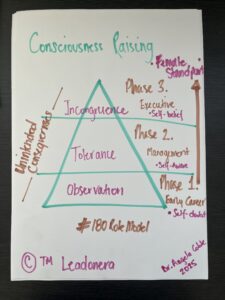
Australia-first research into technology leadership and closing the gender gap
Australia-first research into technology leadership and closing the gender gap It is a unique situation where your life’s purpose, your career and your studies all

It is a unique situation where your life’s purpose, your career and your studies all converge to produce an opportunity to give back; to leave a legacy; to make a difference; to provide context on leadership in a time where leadership styles are disrupted and only a few leader styles will emerge as the more beneficial to person, career, organization and country. I am fortunate that my life’s journey has led me to this point where I can announce that I am leading an Australian first research into leadership in senior technology roles at a time when technology is accelerating and disrupting like no other and the leadership traits of our technology executives will either have us all succeeding or flailing. And how this research will contribute to closing the gender gap in technology-focused leadership roles in Australia.
During the height of COVID Wave 1 in Australia in March 2020 and the substantial disruption in my work and family environment as with every other Australian, I found myself at a culmination of 18mths of intense planning towards acceptance to be enrolled as a Doctoral student, defending my intended research to a panel of prodigious academics as I successfully completed my Confirmation of Candidature and worked through 3mths post acceptance to obtain my Ethics Clearance for Human-based evidence gathering (approved).
It is now time – I can start the research! My research is data-driven and will give insights into best-practice of senior technology leadership requirements whilst providing practical reforms in policy and program to support increased gender parity in senior tech roles in Australia. I cannot think of a better time to complete my research and release my publications for peer review, as we lead through; out of; and thrive in, a post-COVID world accelerated by technology – there is no doubt in my mind that these senior technology leaders will be critical to our country’s future success, not just our companies, but, befitting the research…do we have the right leadership styles in the right technology executive roles in Australia? Let us see what the data says!!
The next 6mths will be a joyous time for me as I interview many consented participants and gather the data that will inform the research and subsequent publications. I expect my first publication to be ready in early 2021. If you are interested, at why I am so driven to complete this research and on a Saturday night at 11pm whilst my family are sleeping, I am reading literature to add more depth to my research and setting up my participant enrolments – then have a read below! Note: I snuck into the home office only after my family got my uninterrupted time over dinner, an at home movie and were already sound asleep – Hubbee included. It is never a doubt to those around me that my research is important but so is being a Wife, a Mum, a Daughter, a Sister, a Niece, a Friend, a Work Colleague, a Neighbor. It is important we have research that informs the way forward in these critical leadership roles and supports as an outcome closing the evident gender gap prevalent in Technology. But it is also important that I am a whole person.
Overview…
An examination of the current and future leadership requirements of senior leadership technology roles in Australia and its relevance to closing the leadership gender gap in the profession.
By: Angela Coble
There is a lack of current empirical research or conceptual literature on leadership context and requirements to succeed in future senior leadership technology roles in Australia (Warne et al. 2011). Additionally, despite decades of policy and strategy focused on advancing and supporting women in the workforce, there are still fewer women in positions of leadership as reported by the Australian Bureau of Statistics (2018) and Workplace Gender Equality Agency (2018). It is acknowledged that skills in science, technology, engineering and math’s (STEM) will be the foundation for economic growth in the future ((Australian Academy of Science 2019) and regrettably there are far fewer women entering or remaining in STEM-related fields with current statistics in Australia hovering at 16% (Australian Academy of Science 2019). It is probable that this poor rate of participation is contributing to a deficit of women in positions of STEM leadership (Shein 2018)) and highlights the need for further research on leadership behaviours required for senior technology roles in Australia.
Most technology framed leadership research is from America or India (Divya & Suganthi 2017), however these cultures are vastly different from Australia, where studies reveal we are grouped more with the European countries in our cultural heritage and norms (Stankov 2016). In the literature, there is a broad body of work related to gender equality in STEM yet it is difficult to extract the technology relevant research with greater emphases on the science, engineering and math’s components (Shein 2018). This situation highlights and strengthens the need for locally focused, globally relevant, research to move Australia away from being reliant on empirical research from other regions to provide insight regarding technology leadership and gender parity inputs. Our country requires research from the Australian setting to guide and inform new government policy or dispute our previous attempts to solve parity in technology-related disciplines.
With the coming of the Fourth Industrial Revolution that creates a fusion of technology, blurring traditional boundaries between the physical, digital, and biological spheres (World Economic Forum 2018), it is critical that Australian research is available to address the leadership requirements of technology roles. The main objective of this research is to explore the current and future leadership requirements of senior leadership technology roles in Australia and its relevance to closing the leadership gender gap in the profession. This research will draw from a vast array of Leadership Theories and Feminine Technoscience Theory as a Science Technology and Social concept (Rost 1993); (Weber 2006) as qualitative data is collected from purposive and critical sampling (Lindlof 2002); (Patton 2002) to inform an exploratory study.
The outcomes will provide practical frameworks to assist organisations in Australia to adopt an active strategy to change their technology leadership in-line with a thematic analysis (Ketokivi & Mantere 2010) explored in this research and develop a pathway to include more female representation in their succession bench for their technology leadership roles. Furthermore, it is intended that this research will inform government policy to support business initiatives for increasing female workforce participation in technology as a key input to boosting Australia’s productivity and innovation as reported by the Workplace Gender Equality Agency (2018).
Australia must be self-reliant with current research to leverage for our country’s future to guide and inform new policy or dispute our previous attempts to solve gender parity in technology-related disciplines. The benefits to Australia’s gross domestic product are compelling, with just a 1% shift of Australia’s workforce into STEM could contribute $57.4billion to the nations GDP over the next 20 years (Australian Academy of Science 2019) and with 47.5% of the Australian workforce women (Australian Bureau of Statistics 2018), a focus on gender specific policy in technology is opportune.
Sources:
Australian Academy of Science 2019, Women in STEM decadal plan, Australia.
Australian Breau of Statistics 2018, Understanding measures of the gender pay gap, ABS, Australia, 23 January 2019 here
Divya, S & Suganthi, L 2017, ‘Study of authentic-transformational leadership styles in information technology sector – a canonical correlational study.’, International Journal of Management Concepts and Philosophy, vol. 10, no. 4, p. 424.
Ketokivi, M & Mantere, S 2010, ‘Two strategies for inductive reasoning in organizational research’, Academy of Management Review, vol. 35, no. 2, pp. 315-33.
Lindlof, TR 2002, Qualitative communication research methods, 2nd ed. / Thomas R. Lindlof and Bryan C. Taylor. edn, Sage Publications, Thousand Oaks, Calif.
Patton, MQ 2002, Qualitative research and evaluation methods, 3rd ed. edn, Sage Publications, Thousand Oaks, Calif.
Rost, JC 1993, Leadership for the Twenty-first century, Praeger Publishers, https://library-books24x7-com.ezproxy.usq.edu.au/toc.aspx?bookid=7399>.
Shein, E 2018, ‘Broadening the path for women in STEM’, Communications of the ACM, vol. 61, no. 8, pp. 19-21.
Stankov, L 2016, ‘Individual differences within the psychological atlas of the world’, Personality and Individual Differences, vol. 94, pp. 180-8.
Warne, L, Bandias, S & Fuller, D 2011, ‘The employment experiences of women in the Australian information communication technology industry’, Economic and social policy, vol. 14, no. 1.
Weber, J 2006, ‘From science and technology to feminist technoscience’, in Handbook of gender and women’s studies, SAGE Publications Ltd, London, pp. 397-414 http://sk.sagepub.com/reference/hdbk_genderstudy>.
Workplace Gender Equality Agency 2018, Australia’s latest gender equality scorecard, Workplace Gender Equality Agency, Australia.
World Economic Forum 2018, The global gender gap report 2018, World Economic Forum.

Australia-first research into technology leadership and closing the gender gap It is a unique situation where your life’s purpose, your career and your studies all

Have you heard the term “Boys Club”? Ever stopped to think what Unintended Consequences a label can create? Sharing some findings today about Clubs and